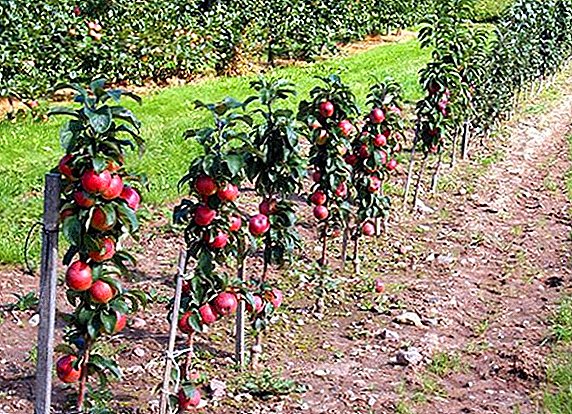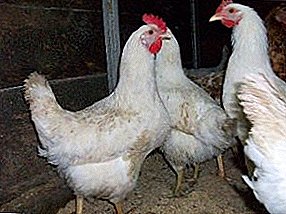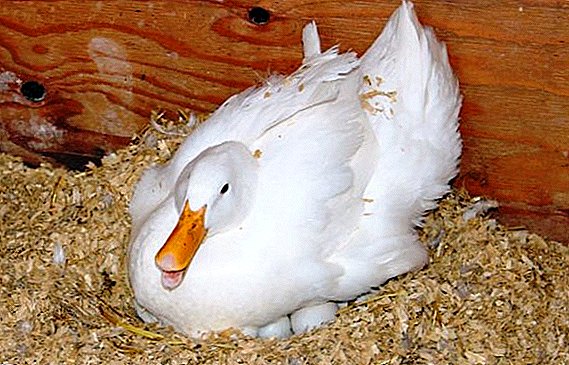 Duck-laying natural eggs is an excellent method for breeding healthy offspring at home. The mother hen itself will bring out, warm and raise the ducklings, will teach them to feed and water. But at the same time, natural incubation is in its own way a complex process, combined with certain difficulties in choosing a hen, preparing a nest, etc. Today we will talk about what needs to be done to set the duck on the eggs and ensure their normal incubation.
Duck-laying natural eggs is an excellent method for breeding healthy offspring at home. The mother hen itself will bring out, warm and raise the ducklings, will teach them to feed and water. But at the same time, natural incubation is in its own way a complex process, combined with certain difficulties in choosing a hen, preparing a nest, etc. Today we will talk about what needs to be done to set the duck on the eggs and ensure their normal incubation.
Choice of hen
Selected in the hen duck, which by its behavior demonstrates willingness to brooding - seeks out secluded places, spreads a nest in peace, is calm and not aggressive in nature, but also without excessive lethargy. You can also try this trick: leave the egg laying in the prepared nest and observe which of the females will sit on the laying. Then you need to try to drive it away from there: if the bird starts to resent, hiss, spread wings, i.e. protect the clutch, this is a sure sign that the female is a good hen.
Did you know? For the first time the ancient Egyptians domesticated the ducks. There are about 110 different species of ducks in the world.
Use and another way: the selected hen is planted on 3-5 unfertilized eggs and is observed for its behavior. If during 4-5 days the duck will protect the nest, return after feeding, then the eggs should be replaced with fertilized ones. But the replacement should be done when the hen is gone - if, for example, she went to eat or drink. 
Nest preparation
This is the second, equally important component of the preparation for hatching, because if the nest is uncomfortable or in the wrong place, the bird may throw the clutch and not return. Based on this, the preparation of the nest should be taken with all responsibility. As a rule, the nest is cooked in the autumn time - then the duck adapts better and will perceive it more calmly.
Important! In the box or box, which is taken as the basis of the nest, there should be no unpleasant smell or smell of other animals.
What and how to make
- The basis of the nest is usually taken quite strong box or box. The bottom is covered with soft bedding, for example, from various dry herbs, but you need to pay special attention so that there are no sharp seeds or spines among the grass.
- In the center of the litter is crushed, but in such a way that the clutch could not scatter over the area of the nest. Do not forget that in duck laying there are from 15 to 20 eggs that are larger than chicken or turkey.
- Taking into account that ducks (wild or domestic) always lay a feather out of their feathers when laying, you need to make an additional layer, better also from duck down - then the duck will feel calmer. Plain or mineral wool is not suitable here - the latter can cause excitement and itching, which is unacceptable for normal incubation.
- When hatching in a cold time, the nest is insulated additionally, but only its part is below: this is done so that the additional insulation does not become any obstacle for the bird.
Read also about the manufacture of the barn and duck feeders.
Video: how to prepare nests for ducks
Where to place
The basic rule for nest placement is a shaded and sheltered place. This rule stems from the instinct of wild ducks to make a nest in a secret place to hide from predators, which was transmitted to their home relatives.
Pets nearby, continuous light and draft will cause the bird to refuse to hatch eggs. The appearance of predators or parasites can also force it to leave the nest, and it is not so important whether it is another duck or other poultry, ferret, or rat that can scare the hen, steal the egg, aim at the ducklings. Such a danger always exists, and in the winter, when there is little food for the “pests”, it increases. Therefore, the poultry farmer needs to eliminate the gaps through which these enemies can get inside.
Learn more about the benefits and uses of duck eggs, in particular, indoutok eggs.
Summarizing the above, we note that the nest should be in a shaded place, sheltered from prying eyes, with clean, moderately moist air and a temperature of at least +10 degrees. 
How to plant a duck on the eggs
Planting is carried out only after a suitable hen has been picked up, the right amount of eggs have been selected and a nest has been prepared.
Direct landing is carried out, taking into account the following rules:
- Daytime air temperature should not be too high.
- First, instead of eggs, their plaster or plastic dummies are put for about 5 days. This is done to strengthen the brood instinct for brooding.
Important! Forced planting improper hen will not give the desired result.
Selection
Equally important is the quality of the testicles that will be placed under the hen. Therefore, in their selection should follow the rule: Eggs must be medium in size, free from shell defects, have the correct shape, and it is desirable that they be from healthy breeding ducks.
Egg preparation
Before laying, they must lie in dryness, without a bright light at a temperature of 15 to 20 degrees no more than 2-5 days.  Separately, there is the question of washing and cleaning the future masonry - there is no consensus on this. Among experienced poultry farmers there are quite a few supporters of the fact that the eggs should be cleaned before laying, however there are many adherents of the point of view that with natural laying there is no need for this manipulation - the duck will hatch without such treatment.
Separately, there is the question of washing and cleaning the future masonry - there is no consensus on this. Among experienced poultry farmers there are quite a few supporters of the fact that the eggs should be cleaned before laying, however there are many adherents of the point of view that with natural laying there is no need for this manipulation - the duck will hatch without such treatment.
We advise you to read about the incubation of duck eggs and breeding ducklings in an incubator.
How many eggs to lay
Making this decision, you need to proceed from several factors, namely:
- Size of hen. If the duck is small, more than a dozen eggs cannot be placed under it. Under the bird of medium or large size, you can lay up to 25 eggs.
- Under the cover of the hen, all the laid eggs should hide: if some do not fit, they should be removed.
Important! Eggs are laid only in one row - ducks laid in two or more rows will not be able to warm up and turn over.
Care for hen during incubation
When the bird itself sat in the nest, you need fix this time. The first two days it does not touch, and on the third hen gently raise and sit down to the trough and drinking bowl; it is not uncommon for this procedure to be done several times until it rises itself for feeding. If, after feeding, the hen does not return to the clutch, it should be transferred there after about forty minutes.  It happens that the bird reluctantly incubates. In this case, take a little fluff from her chest and place in a nest with two or three eggs for the sample. For four days the bird is in a locked nest, it is produced only to the stern and water. As soon as the hen begins to come back on its own, add eggs for full laying.
It happens that the bird reluctantly incubates. In this case, take a little fluff from her chest and place in a nest with two or three eggs for the sample. For four days the bird is in a locked nest, it is produced only to the stern and water. As soon as the hen begins to come back on its own, add eggs for full laying.
Learn how to feed the little ducklings.
How many days does a duck hatch eggs
This period is determined by the breed of duck, its feeding and conditions of detention, as well as the properties, merits and degree of fitness of the eggs. Domestic duck hatches eggs for about a month - 27-28 days. 
Can I put a duck on goose eggs
It is quite possible, but only under a good hen duck: she will be able to sit eggs not only of other breeds, but even of other species of birds.
Did you know? A duck can dive to a depth of more than six meters.
Hatching is the most important process of breeding ducks, requiring proper treatment, diligent preparation and careful control. However, having fulfilled all the necessary requirements and conditions, you can be guaranteed to rely on a large and healthy recruitment in the duck family.












